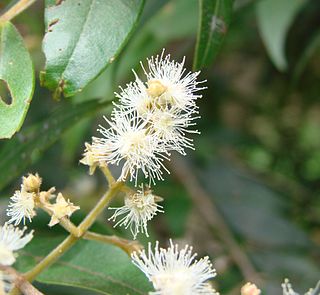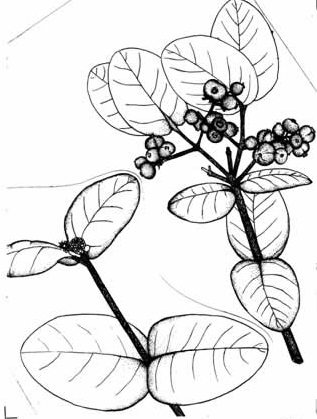
Myrtaceae, the myrtle family, is a family of dicotyledonous plants placed within the order Myrtales. Myrtle, pōhutukawa, bay rum tree, clove, guava, acca (feijoa), allspice, and eucalyptus are some notable members of this group. All species are woody, contain essential oils, and have flower parts in multiples of four or five. The leaves are evergreen, alternate to mostly opposite, simple, and usually entire. The flowers have a base number of five petals, though in several genera, the petals are minute or absent. The stamens are usually very conspicuous, brightly coloured, and numerous.

Psidium is a genus of trees and shrubs in the family Myrtaceae. It is native to warmer parts of the Western Hemisphere.

Myrcia is a genus of plants in the family Myrtaceae, containing about 765 species as of 2022. They are distributed in Central and South America, Mexico, and the Caribbean, with centers of diversity in the Brazilian Cerrado and Atlantic Forests ecoregions. Myrcia was first described as a genus in 1827.

Myrcia sintenisiana is a species of flowering plant in the family Myrtaceae. It is endemic to Puerto Rico, where it is limited to the Luquillo Mountains. It occurs in El Yunque National Forest in dwarf forest habitat on wet mountain ridges. Its common name is beruquillo.

Thismia is a genus of myco-heterotrophic plants in family Burmanniaceae, first described as a genus in 1845. It is native to East and Southeast Asia, New Guinea, Australia, New Zealand, and the Americas.
Verticordia attenuata is a flowering plant in the myrtle family, Myrtaceae and is endemic to the south-west of Western Australia. It is a shrub with a single main stem, small leaves and pink to purple flowers which fade to white as they age. It usually grows in sand in areas that are wet in winter, often amongst grasses and is found in coastal areas near Bunbury.

Dudleya attenuata is a species of perennial succulent plant known by the common name taper-tip liveforever, native to Baja California and a small portion of California. A rosette-forming leaf succulent, it has narrow pencil shaped leaves that can often be found covered in a white epicuticular wax. The thin, sprawling stems branch to form the clusters of rosettes, with plants creating a "clump" up to 40 cm wide. The small flowers are white or yellow, with 5 spreading petals. It is a diverse, variable species that extends from the southernmost coast of San Diego County to an area slightly north of the Vizcaino Desert, hybridizing with many other species of Dudleya in its range. Some plants with white or pinkish flowers were referred to as Orcutt's liveforever, referring to a former subspecies split on the basis of the flower color.
Calycolpus warscewiczianus is a plant species native to Nicaragua, Costa Rica, Panamá and Venezuela.
Verticordia mitodes is a flowering plant in the myrtle family, Myrtaceae and is endemic to the south-west of Western Australia. It is a shrub with a single, highly-branched main stem, small leaves and small spikes of magenta-coloured flowers in late spring.

Myrcia guianensis (pedra-ume-caá) is a species of plant in the genus Myrcia of the family Myrtaceae native to South America.
Myrcia crassa is a species of plant in the family Myrtaceae. It is endemic to the municipality of Santa Teresa, Espírito Santo, Brazil, where its habitat is fragmented and declining due to deforestation. The tree was first described in 2010 and grows to between 1.5 and 18 metres tall.
Myrcia floridissima is a species of plant in the family Myrtaceae. It is endemic to the atlantic rainforest of eastern Minas Gerais, Brazil, where its habitat is fragmented and declining due to deforestation. The tree was first described in 2010 and grows up to 6 metres tall.
Plinia rivularis, commonly known as yva poroity, jaboticabarana, jabúriti, guapuriti, cambucá peixoto, jabuticaba de cacho, or piuna is a species of plant in the family Myrtaceae.
Myrciaria cambuca, named after its common name cambucá, is a species of plant in the family Myrtaceae. First described in 2019, it is a small shrub with reddish fruit, and was previously misidentified as Myrciaria ferruginea.
Myrciaria una is a species of plant in the family Myrtaceae. First described in 2019, it is a tree or treelet with blackish fruit, and was previously misidentified as Myrciaria ferruginea.
Myrcia ascendens is a species of plant in the family Myrtaceae, endemic to Bahia in north-east Brazil, and first described in 2015.
Myrcia costeira is a species of plant in the family Myrtaceae, endemic to the south and south-east of Brazil, and first described in 2015.
Myrcia rupestris is a species of plant in the family Myrtaceae, endemic to south-east Brazil, and first described in 2015.
Myrcia subterminalis is a species of plant in the family Myrtaceae, endemic to the east of Brazil, and first described in 2015.
Metrosideros tabwemasanaensis is species of plant in the family Myrtaceae. It is a tree endemic to Mount Tabwemasana on the island of Espiritu Santo in Vanuatu.






